Generally: inquiries
inquiry (1)
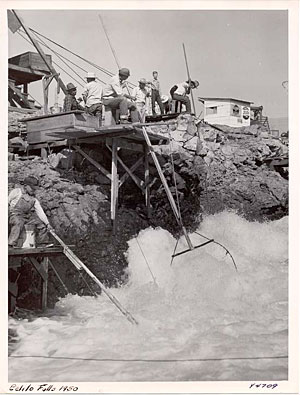
Indigenous people fishing at Celilo Falls
on the Columbia River, 1950
(dammed 1957).
ODOT Historical Travel Photos
inquiry (2)
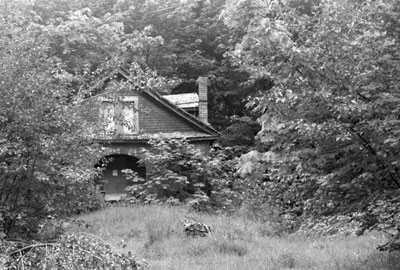
William J. Faubion House
Zigzag, OR (built ca. 1908)
[June 2002]
inquiry (3)
It is a long story and a sad story, not yet complete and not entirely knowable – mainly about the past and how to deal with it. For lack of evidence, I’ll skip the beginning, though the middle is hearsay and the end has not yet arrived. Starting, then, in media res: the old man died sometime around 1944 – perhaps as early as 1938, perhaps as late as 1946, I haven’t yet checked. The old man was the original homesteader, government patent, freshly stolen from the salmon-fishing natives in nineteen-aught-seven. He built the house sometime around 1908, if one can believe the crumpled newspapers (Oakland Tribune, June 16, 1908 & December (something) of the same year) used for insulation. It is said he kept a hotel in addition to starting a post-office, but the sources decline to corroborate that fact. In any case, he died, and the property was sold to a gentleman whom I (for the sake of convenience) shall call Gustav. Gustav was not, so far as I know, related to the family, though the old man had three daughters and two sons; of these, only one daughter takes a stand in the historical records, as the firm wife of one of the older local families (they came west in the 1860s) a character, a shop-keeper, and prudent investor in golf-courses.
Returning, however, to Gustav – he kept the house for only a short time, selling it in 1946 to a fellow called Ed, who planned to fix the place up. Whether Ed meant to modernize the old house or refurbish it is unclear, but he dug a large pit under it and put up drywall in places drywall had little business being. He claimed that his wife was related to the old man (‘a distant cousin’) and he was keeping the place in the family, but this may be wishful thinking. He also found time to build a ramshackle folly of a house from the odds and ends of wood and stone he happened to have lying about. In the fullness of time (as the saying goes) he also had two sons; rather, his wife bore one son, Gabriel, and they adopted another, whom I’ll call Joe. Both boys were indulged by their father, who was as lenient as he was temperamental. Leniency and rages do not the best of children breed, and if not whip-smart, the two boys grew at least to be sharper than a serpent’s tooth.
Sometime in the 1980s the old house was placed on the register of historic homes—a process as easy as not answering a letter: Ed, we want to place the house on the register of historic homes, unless we hear from you, we shall do so, Yours Sincerely, Oregon Historical Whatsit. This despite the destruction of the original stone fireplaces and retaining walls, despite the lack of interior walls (except for the drywall installed by Ed) and the absence of stairs and numerous window panes. Now the story turns: Ed’s wife died in the early 90s and Ed signed over his power of attorney to his eldest son, Gabriel, who by then lived in a nearby town. Why Ed did so boggles the mind—perhaps he thought this would cause Gabriel to manage the upkeep of the place and take care of his old dad. Gabriel did nothing of the sort, but logged the property to fund his own private ventures, concerning the nature of which I am thankfully ignorant. Whether it was the death of his wife, or the logging of the property, or the decrepitude of everything around him, Ed hanged himself in 1997 and left the property to Joe, who mortgaged it within the month.
inquiry (4)
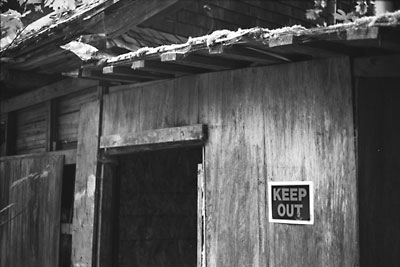
William J. Faubion House
Zigzag, OR (built ca. 1908)
[August 2003]
inquiry (5)
Game was plentiful and at times a drove of elk could be seen on Hunchback mountain which at that time was bare of timber. Food consisted of fresh meat they could kill, beans, bacon, potatoes and dried fruit.
Together they cut all trees in the valley, mostly alder. One year late in August, they set fire to the slashing. It was bone dry and burned clean. That fall they sowed timothy seed in the burned over area and in the spring it grew head high. Now they had feed for their cattle.
About 1890 they built a new house. This attracted summer vacationers, who came by the day. Then came the Indians on their ponies to pick huckleberries and to fish. Salmon were so plentiful, Indians rode their ponies into the river and speared the fish. They built dryers along the river and flies accumulated by the millions. Some stench! It became unbearable and Uncle Sam Welch drove them off his land. The Indians moved down the river where Arrah Wanna is now. Until 1920 the Indians came down Huckleberry Mountain with berries for sale.
inquiry (6)
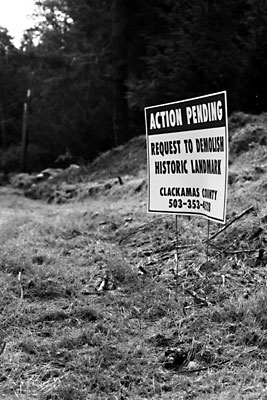
Historical inevitability.
inquiry (7)
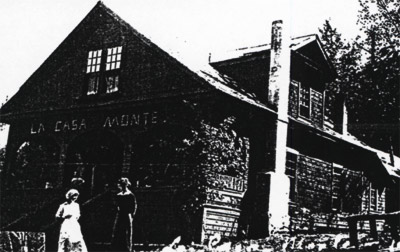
‘La Casa Monte’, ca. 1914
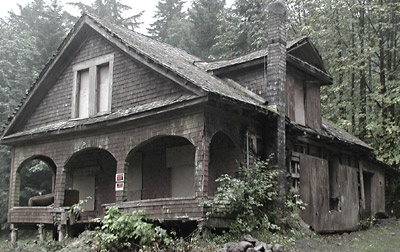
Faubion House, ca. 2003
inquiry (8)
These people have excellent sculptors and professional designers. Their pipes, tomahawks, sticks, spoons carved out of horn, etc., embellish our ethnographic collections.
